1994 CHEVROLET S10 automatic transmission fluid
[x] Cancel search: automatic transmission fluidPage 180 of 340

Downloaded from www.Manualslib.com manuals search engine - . ?
-. “C ^.
When You Are Ready to Leave After Parking on a Hill
1. Apply your regular brakes and hold the pedal down while you:
Start your engine;
Shift into a gear; and
Release the parking brake.
2. Let up on the brake pedal.
3. Drive slowly until the trailer is clear of the chocks.
4. Stop and have someone pick up and store the chocks.
Maintenance When Trailer Towing
Your vehicle will need service more often when you’re pulling a trailer. See
the Maintenance Schedule for more on this. Things that are especially
important in trailer operation are automatic transmission fluid (don’t
overfill), engine oil, axle lubricant, belt, cooling system, an\
d brake
adjustment. Each
of these is covered in this manual, and the Index will help
you find them quickly.
If you’re trailering, it’s a good idea to review these
sections before you
start your trip.
Check periodically to see that all hitch nuts and bolts are tight.
Trailer Light Wiring
See “Trailer Wiring Harness” in the Index.
4-44
I b
Page 219 of 340
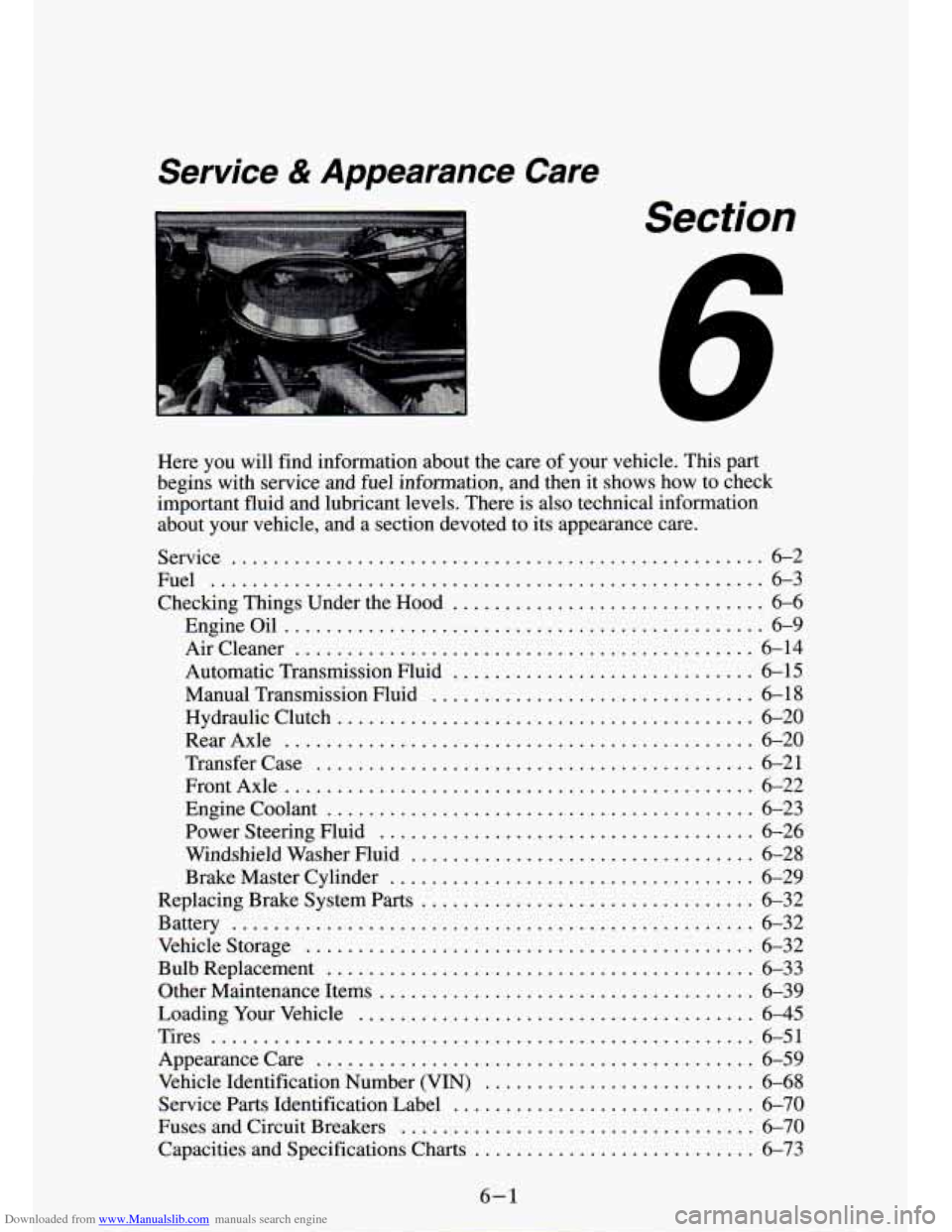
Downloaded from www.Manualslib.com manuals search engine Service & Appearance Care
I
Section
Here you will find information about the care of your vehicle . This part
begins with service and fuel information. and then it shows ho\
w to check important fluid and lubricant levels
. There is also technical information
about your vehicle. and a section devoted to its appearance care
.
Service ................................................... 6-2
Fuel
..................................................... 6-3
Engineoil
.............................................. 6-9
Aircleaner
............................................ 6-14
Automatic Transmission Fluid
............................. 6-15
Manual Transmission Fluid
............................... 6-18
Hydraulic Clutch
........................................ 6-20
RearAxle
............................................. 6-20
Transfer Case
.......................................... 6-21
FrontAxle
............................................. 6-22
Power Steering Fluid
.................................... 6-26
Windshield Washer Fluid
................................. 6-28
Checking Things Under the Hood
.............................. 6-6
Engine Coolant
......................................... 6-23
Brake Master Cylinder
................................... 6-29
Replacing Brake System Parts
................................ 6-32
Bulb Replacement
......................................... 6-33
Battery
.................................................. 6-32
Vehiclestorage
........................................... 6-32
Other Maintenance Items
.................................... 6-39
Loading Your Vehicle
...................................... 6-45
Tires
.................................................... 6-51
Appearancecare
.......................................... 6-59
Vehicle Identification Number (VIN)
.......................... 6-68
Service Parts Identification Label
............................. 6-70
Fuses and Circuit Breakers
.................................. 6-70
Capacities and Specifications Charts
........................... 6-73
6-1
Page 233 of 340
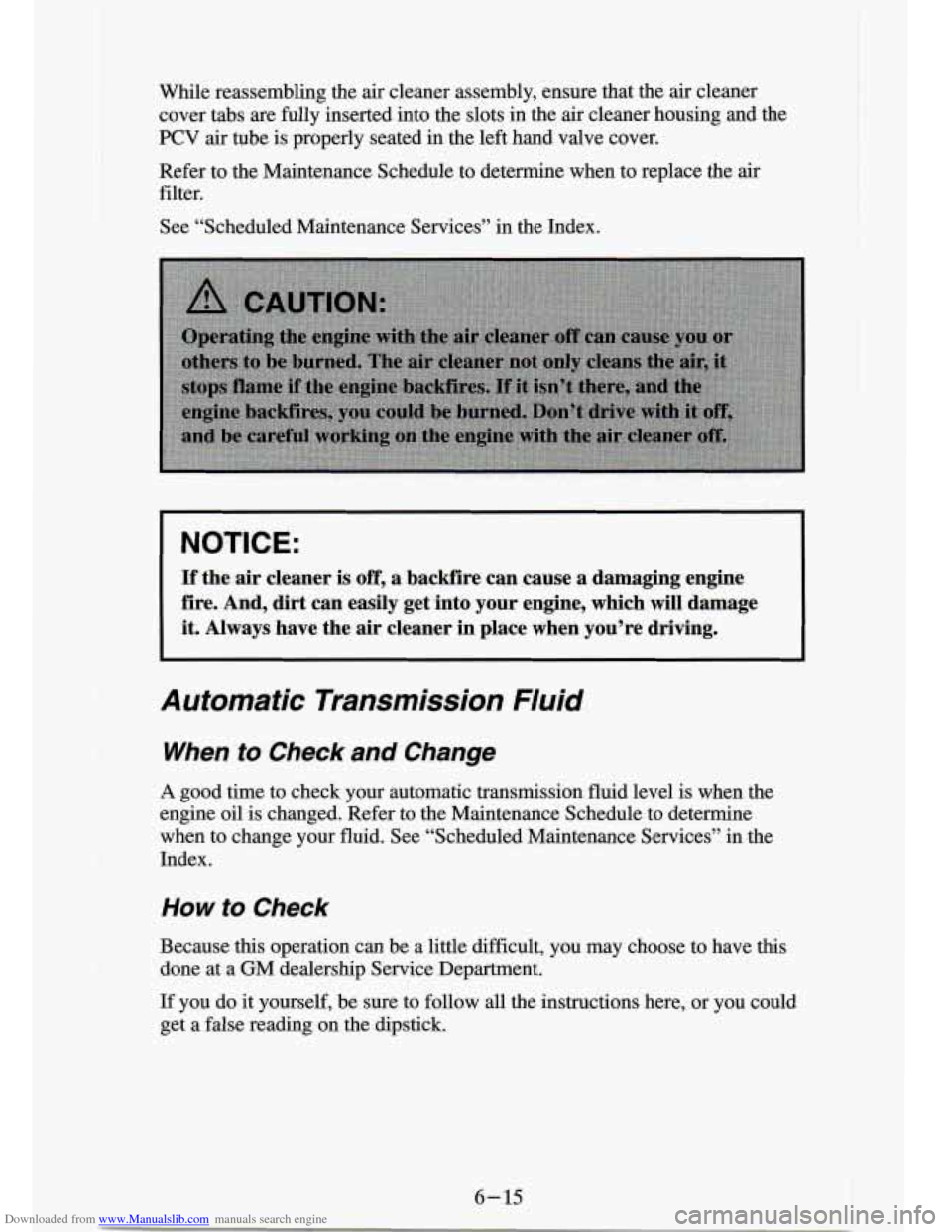
Downloaded from www.Manualslib.com manuals search engine While reassembling the air cleaner assembly, ensure that the air cleaner
cover tabs
are fully inserted into the slots in the air cleaner housing and the
PCV air tube is properly seated in the left hand valve cover.
Refer to
the Maintenance Schedule to determine when to replace the air
filter.
See “Scheduled Maintenance Services”
in the Index.
NOTICE:
If’ the air cleaner is off, a backfire can cause a damaging engine
fire.
And, dirt can easily get into your engine, which will damage
it. Always have the
air cleaner in place when you’re driving.
Automatic Transmission Fluid
When to Check and Change
A good time to check your automatic transmission fluid level is when the
engine oil is changed. Refer to the Maintenance Schedule to determine
when to change your fluid. See “Scheduled Maintenance Services” in the
Index.
How to Check
Because this operation can be a little difficult, you may choose to have this
done at a
GM dealership Service Department.
If you
do it yourself, be sure to follow all the instructions here, or you \
could
get a false reading on the dipstick.
6-15 I
Page 236 of 340
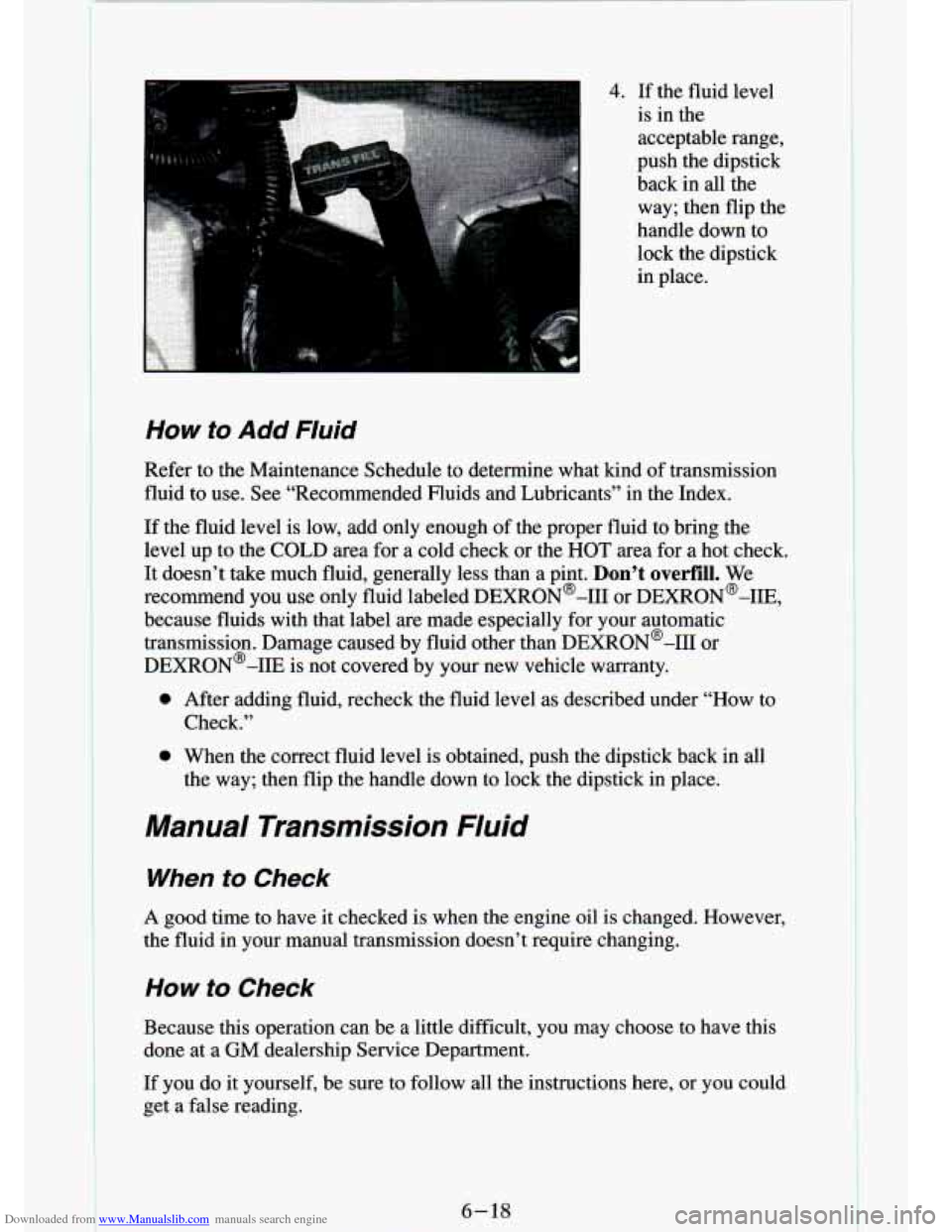
Downloaded from www.Manualslib.com manuals search engine 4. If the fluid level
is in the
acceptable range,
push the dipstick
back in all the
way; then flip the
handle down to
lock the dipstick
in place.
How to Add Fluid
Refer to the Maintenance Schedule to determine what kind of transmission
fluid to use. See “Recommended Fluids and Lubricants”
in the Index.
If the fluid level is low, add only enough of the proper fluid to bring the
level up to the COLD area for a cold check or the
HOT area for a hot check.
It doesn’t take much fluid, generally less than a pint.
Don’t overfill. We
recommend you use only fluid labeled DEXRON@-I11 or DEXRON@-IIE,
because fluids with that label are made especially for your automatic
transmission. Damage caused by fluid other than DEXRON@-I11 or
DEXR0N’-IIE is not covered by your new vehicle warranty.
0 After adding fluid, recheck the fluid level as described under “How to
Check.”
0 When the correct fluid level is obtained, push the dipstick ba\
ck in all
the way; then flip the handle down to lock the dipstick in place.
Manual Transmission Fluid
When to Check
A good time to have it checked is when the engine oil is changed. However,
the fluid in your manual transmission
doesn’t require changing.
How to Check
Because this operation can be a little difficult, you may choose to have this
done at a
GM dealership Service Department.
If you do it yourself, be sure to follow all the instructions\
here, or you could get a false reading.
6-18
Page 304 of 340

Downloaded from www.Manualslib.com manuals search engine 6. TRANSMISSION SERVICE:
Automatic Transmission
- Change the transmission fluid and filter
every
15,000 miles (25 000 km) he vehicle is mainly driven under
one or more of these conditions:
0 In heavy city traffic.
0 Where the outside temperature regularly reaches 90°F (32°C) or
0 In hilly or mountainous terrain.
0 Frequent trailer pulling. higher.
Uses such as taxi, police, delivery or other commercial service\
.
If the vehicle is not used mainly under any of these conditions, change
the fluid and filter every
30,000 miles (50 000 km). See “Automatic
Transmission Fluid” in the Index for more information.
Manual Transmission - Transrnission fluid does not require periodic
changing.
specified interval or sooner if clogged.
7. FUEL FILTER REPLACEMENT* - Replace the fuel filter at the
8. SPARK PLUG REPLACEMENT*$ - Replace spark plugs with the
type listed
in Section 6. Spark plugs (AC908) for the 2.2L Engine (VIN
Code 4) should be replaced every 100,000 miles (166 000 kilometers).
Spark plugs (.CR43TSM) for the 4.3L engines
(VIN Codes W and Z)
should be replaced every 30,000 miles (50 000 kilometers). See
‘‘Specification Charts” in the Index.
9. SPARK PLUG WIRE INSPECTION* - Clean wires and inspect
for burns, cracks or other damage. Check the wire boot fit at the
distributor and at the spark plugs. Replace wires as needed.
Adjust timing to underhood label specifications. Inspect the ins\
ide and outside
of the distributor cap and rotor for cracks, carbon tracking and
corrosion. Clean or replace as needed.
10. ENGINE TIMING CHECK AND DISTRIBUTOR CHECK*$ -
*An Emission Control Service
$=The California Air Resources Board has detennined that the fa\
ilure to
perform this maintenance item will not nullify the emission war\
ranty or limit recall liability prior to the completion
of vehicle usefui life. General
Motors, however, urges that all recommended maintenance services \
be
performed at the indicated intervals and the maintenance be rec\
orded.
7-8
Page 306 of 340
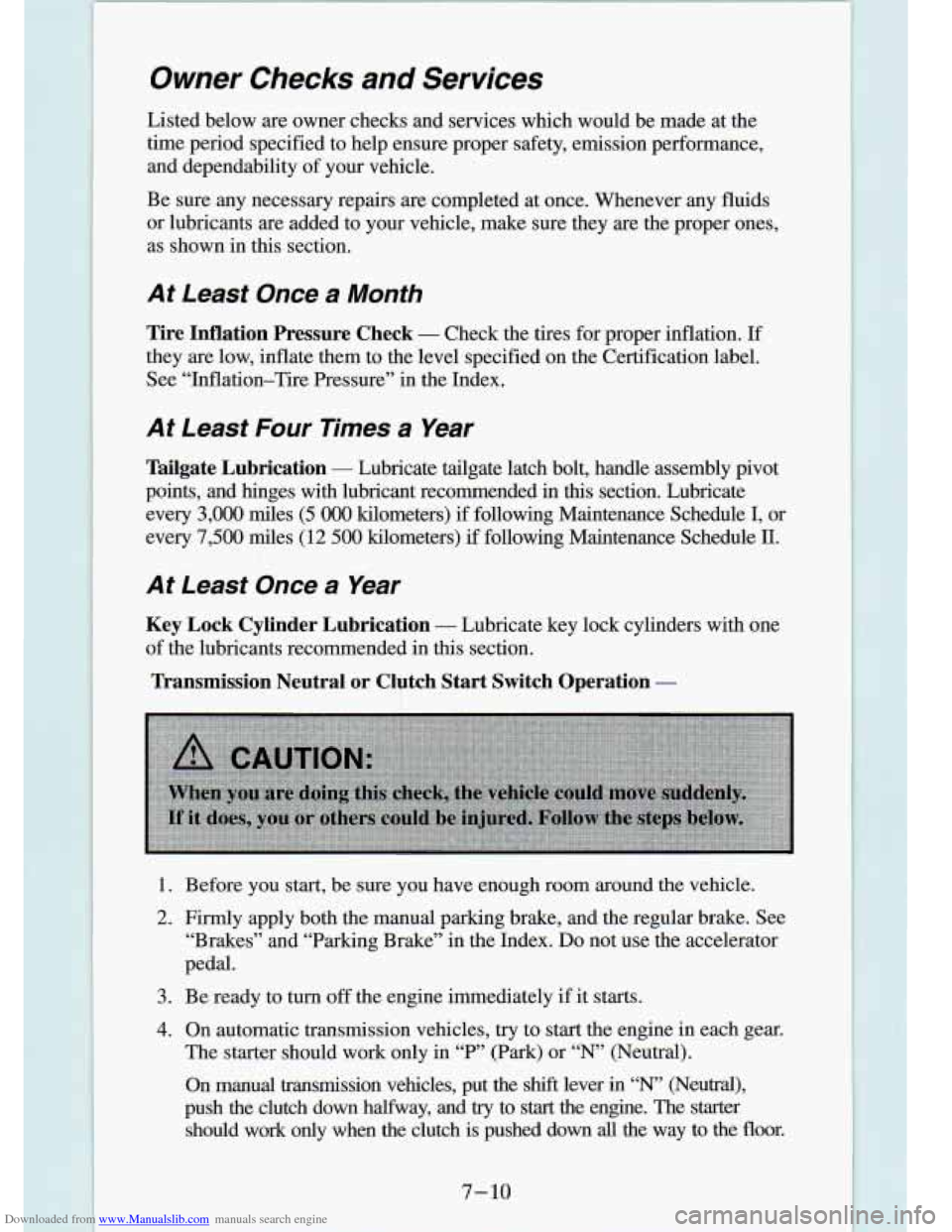
Downloaded from www.Manualslib.com manuals search engine Owner Checks and Services
Listed below are owner checks and services which would be made\
at the
time period specified to help ensure proper safety, emission pe\
rformance,
and dependability
of your vehicle.
Be sure any necessary repairs
are completed at once. Whenever any fluids
or lubricants are added to your vehicle, make sure they are t\
he proper ones,
as shown in this section.
At Least Once a Month
Tire Inflation Pressure Check - Check the tires for proper inflation. If
they
are low, inflate them to the level specified on the Certification \
label.
See “Inflation-Tire Pressure” in the Index.
At feast Four Times a Year
Tailgate Lubrication - Lubricate tailgate latch bolt, handle assembly pivot
points, and hinges with lubricant recommended in
this section. Lubricate
every
3,000 miles (5 000 kilometers) if following Maintenance Schedule I, or
every
7,500 &les (12 500 kilometers) if following Maintenance Schedule II.
At Least Once a Year
Key Lock Cylinder Lubrication - Lubricate key lock cylinders with one
of the lubricants recammended in
this section.
Transmission Neutral or Clutch Start Switch Operation -
1.
2.
3.
4.
Before you start, be sure you have enough room around the veh\
icle.
Firmly apply both the manual parking brake, and the regular br\
ake. See
“Brakes” and “Parking Brake” in the Index.
Do not use the accelerator
pedal.
Be ready to
turn off the engine immediately if it starts.
On automatic transmission vehicles,
try to start the engine in each gear.
The starter should work only in
T“ (Park) or “N’ (Neutral).
On manual transmission vehicles, put the shift lever in “N’ (Neutral),
push the clutch down halfway, and
try to start the engine. The starter
should work only when the clutch is pushed down
all the way to the floor.
7-10
Page 309 of 340
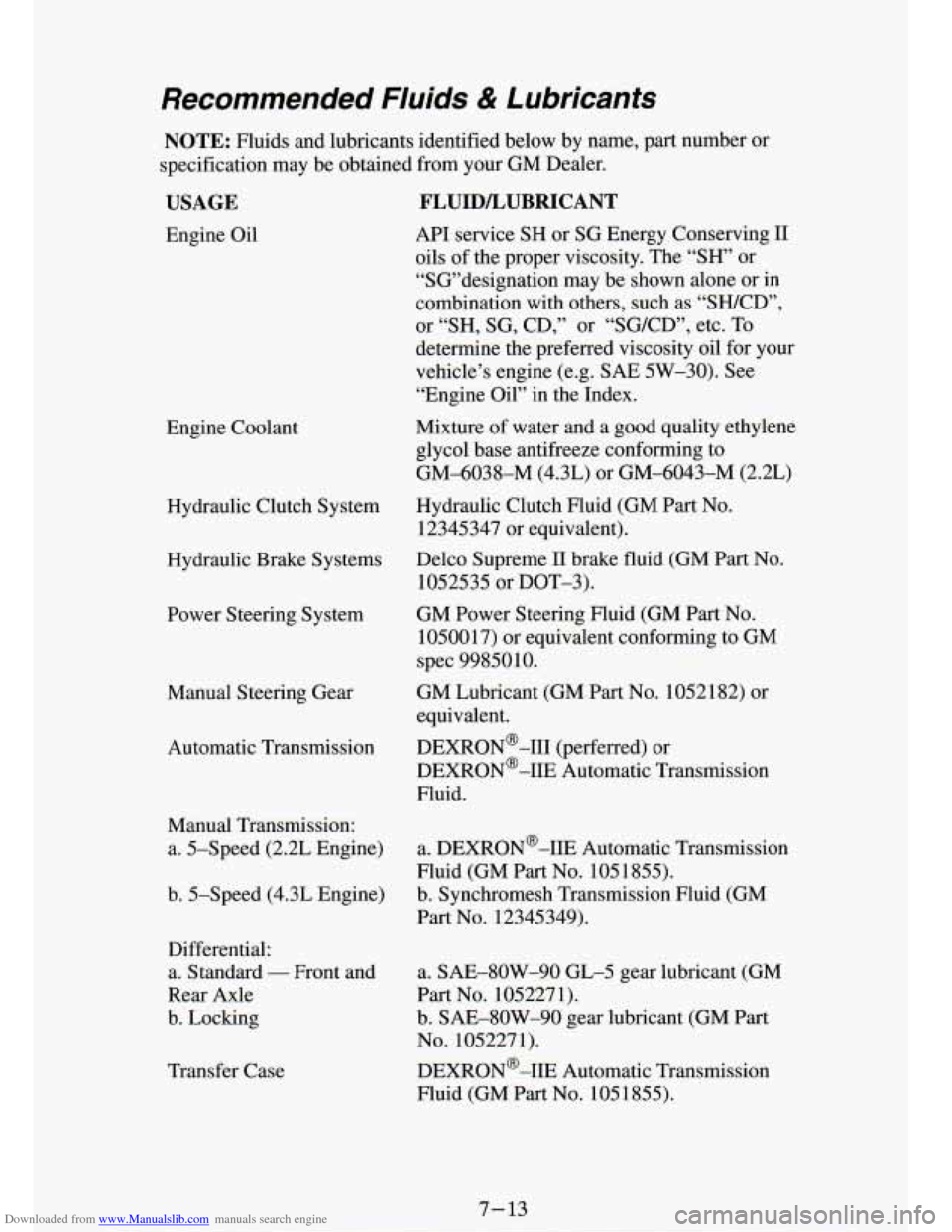
Downloaded from www.Manualslib.com manuals search engine Recommended Fluids & Lubricants
NOTE: Fluids and lubricants identified below by name, part number or
specification may be obtained
from your GM Dealer.
USAGE
Engine Oil
Engine Coolant Hydraulic Clutch System
Hydraulic Brake Systems
Power Steering System
Manual Steering Gear Automatic Transmission
Manual
Iransrmssu
a. 5-Speed (2.2L Engine)
b. 5-Speed (4.3L Engine)
FLUIDLUBRICANT
API service SH or SG Energy Conserving I1
oils of the proper viscosity. The “SH” or
“SG’designation may be shown alone or in
combination with others, such as “SH/CD”,
or “SH, SG, CD,” or “SGKD”, etc. To
determine the preferred viscosity oil for your
vehicle’s engine (e.g. SAE 5W-30). See
“Engine Oil” in the Index.
Mixture of water and a good quality ethylene
glycol base antifreeze conforming to
GM-6038-M (4.3L) or GM-6043-M (2.2L)
Hydraulic Clutch Fluid (GM Part
No.
12345347 or equivalent).
Delco Supreme
11 brake fluid (GM Part No.
1052535 or DOT-3).
GM Power Steering Fluid (GM Part No.
1050017) or equivalent conforming to GM
spec 9985010.
GM Lubricant (GM Part No. 1052182) or
equivalent. DEXRON@-III (perferred) or
DEXRON@-IIE Automatic Transmission
Fluid.
a. DEXRON@-IIE Automatic Transmission
Fluid (GM Part No. 1051855).
b. Synchromesh Transmission Fluid (GM
Part
No. 12345349).
Differential: a. Standard
- Front and a. SAE-8OW-90 GL-5 gear lubricant (GM
Rear Axle Part No. 1052271).
b. Locking b. SAE-SOW-90 gear lubricant (GM Part
No. 1052271).
DEXRON@-IIE Automatic Transmission
Fluid (GM Part No.
1051855).
Transfer Case
7 -23
Page 313 of 340

Downloaded from www.Manualslib.com manuals search engine Hood Release
Lever
See Page 6-6.
Remote Oil Filfer
See Page
6-1 3.
Windshield -
Washer Fluid
See Page 6-28.
Power Steering '
Reservoir
See Page 6-26.
,Battery
The Delco
Freedom battery
needs no water.
See Page 6-32. I 4
,Cooling Sysfem
Check and add
coolant
only at
the coolant
recovery tank.
See Page 6-23.
I fit-
Engine Oil
\see Page 6-9m Transmission
Fluid
Automatic:
See Page 6-15.
Manual:
See Page 6-18.
/ Clutch Fluid
Reservoir
See Page 6-20.
I
I c
/
,Fuel
Capacity 20 U.S.
Gal.
(7.6L). Use
unleaded gas
only,
87 octane
or higher.
See Page 6-3.
Brake Fluid.
Reservoir
See Page 6-29.
Cold TiFe
Pressure
See Tire-Loading
sticker
on the
inside
of the
rear edge
of
the driver's door lock pillar.
See Page 6-45.
Spare Tire /
Pressure
See Page 6-45.
7- 17